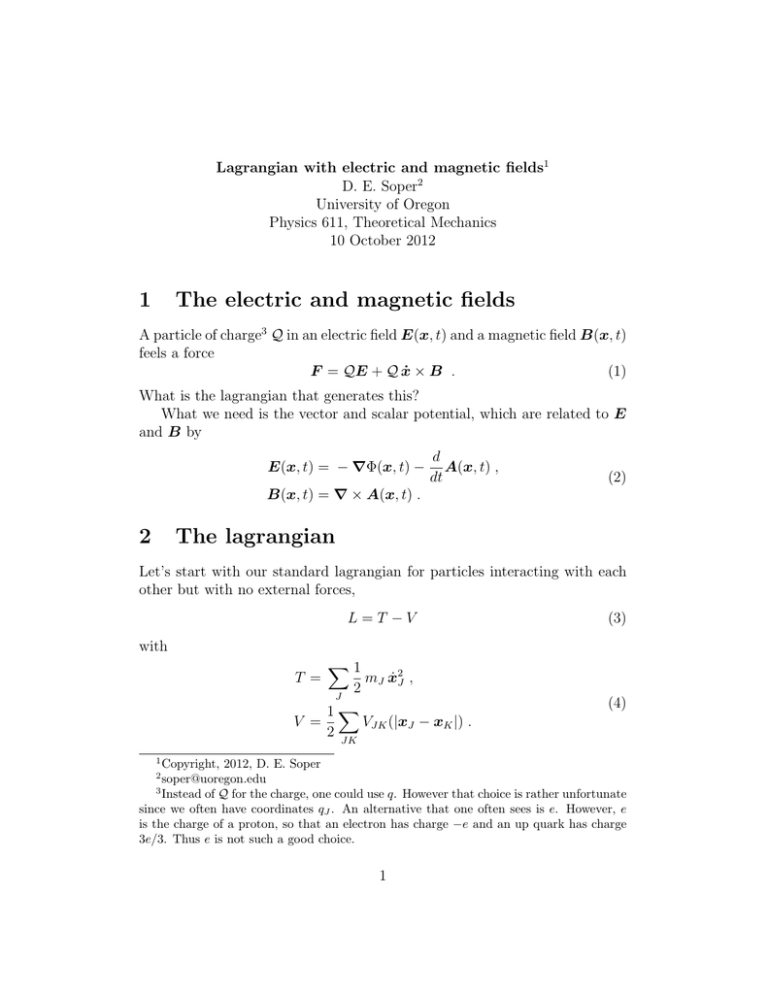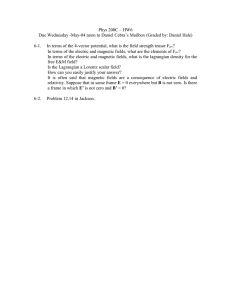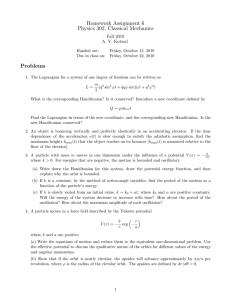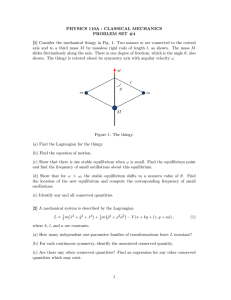Lagrangian with electric and magnetic fields
advertisement

Lagrangian with electric and magnetic fields1 D. E. Soper2 University of Oregon Physics 611, Theoretical Mechanics 10 October 2012 1 The electric and magnetic fields A particle of charge3 Q in an electric field E(x, t) and a magnetic field B(x, t) feels a force F = QE + Q ẋ × B . (1) What is the lagrangian that generates this? What we need is the vector and scalar potential, which are related to E and B by E(x, t) = − ∇Φ(x, t) − d A(x, t) , dt (2) B(x, t) = ∇ × A(x, t) . 2 The lagrangian Let’s start with our standard lagrangian for particles interacting with each other but with no external forces, L=T −V (3) with T = X1 2 X 1 mJ ẋ2J , J V = 2 (4) VJK (|xJ − xK |) . JK 1 Copyright, 2012, D. E. Soper soper@uoregon.edu 3 Instead of Q for the charge, one could use q. However that choice is rather unfortunate since we often have coordinates qJ . An alternative that one often sees is e. However, e is the charge of a proton, so that an electron has charge −e and an up quark has charge 3e/3. Thus e is not such a good choice. 2 1 Now we add an interaction with the external fields, X (e) L=T −V + LJ . (5) J We just take a guess and see if it does what we want: (e) LJ = QJ ẋJ · A(xJ , t) − QJ Φ(xJ , t) . (6) We need (using explicitly the components xiJ of xJ ) (e) d ∂LJ (xJ , ẋJ , t) d = QJ Ai (xJ , t) i dt ∂ ẋJ dt ∂Ai (xJ , t) ∂Ai (xJ , t) j = QJ + QJ ẋJ ∂t ∂xjJ and (7) (e) j ∂LJ (xJ , ẋJ , t) ∂Φ(xJ , t) j ∂A (xJ , t) = Q ẋ − QJ . J J i i ∂xJ ∂xJ ∂xiJ (8) Thus (e) (e) d ∂LJ (xJ , ẋJ , t) ∂LJ (xJ , ẋJ , t) − + dt ∂ ẋiJ ∂xiJ ∂Φ(xJ , t) ∂Ai (xJ , t) + = − QJ ∂xiJ ∂t j ∂A (xJ , t) ∂Ai (xJ , t) j + QJ − ẋJ ∂xiJ ∂xjJ (9) = QJ E i (xJ , t) + QJ ijk B k (xJ , t) ẋjJ = [QJ E(xJ , t) + QJ ẋJ × B(xJ , t)]i . We have already analyzed what the other terms in the lagrangian contribute to the equations of motion. Putting everything together, we have X mJ ẍJ = QJ E(xJ , t) + QJ ẋJ × B(xJ , t) − ∇VJK (|xJ − xK |) . (10) K We have the effect of internal forces, as previously, but now each particle feels an electromagnetic force of the form (1). We conclude that Eq. (6) was the right guess for the lagrangian. 2 For a single particle with charge Q and position x, the lagrangian is then L= 1 m ẋ2 + Q ẋ · A(x, t) − Q Φ(x, t) , 2 (11) which gives the single particle equation of motion mẍ = QE + Q ẋ × B . (12) Exercise 2.1: Consider the lagrangian Eq. (11) for just one particle. Suppose that Φ and A are independent of time (for fixed x). Then there should be a conserved energy. What is it? Exercise 2.2: Consider equation of motion (12) for just one particle. Suppose that E = 0 and the magnetic field is uniform and time independent and in the z direction, B = B ẑ. Suppose that the particle starts at time 0 at x = 0 with initial velocity v0 = (v01 , v02 , v03 ). Solve the equation of motion to find x(t) as a function of t. Verify that the energy that you found in Exercise 2.1 is conserved. It would seem that this problem has symmetries under translations in the x1 , x2 , and x3 directions and under rotations about the x3 axis. The following exercises explore this issue. In the exercises, I suggest particular choices of A that simplify consideration of each symmetry. One can also use an arbitrary choice of A that gives the desired B for each of the symmetries. This is more elegant, but requires more cleverness. Exercise 2.3: In the case of a particle in a uniform magnetic field as in Exercise 2.2, one could take A1 = − B 2 x , 2 A2 = B 1 x, 2 A3 = 0 . With this chooice of A, the lagrangian is invariant under translations in the x3 direction. Thus there ought to be a corresponding conserved quantity Q. What is Q? Verify directly from your solutions in Exercise 2.2 or from the equations of motion that this quantity is conserved. 3 Exercise 2.4: In the case of a particle in a uniform magnetic field as in Exercise 2.2, one could take A1 = 0 , A2 = Bx1 , A3 = 0 . With this chooice of A, the lagrangian is invariant under translations in the x2 direction. Thus there ought to be a corresponding conserved quantity Q. What is Q? Verify directly from your solutions in Exercise 2.2 or from the equations of motion that this quantity is conserved. Exercise 2.5: In the case of a particle in a uniform magnetic field as in Exercise 2.2, one could take A1 = − B 2 x , 2 A2 = B 1 x, 2 A3 = 0 . Show that with this chooice of A, the lagrangian is invariant under rotations about the x3 axis. Thus there ought to be a corresponding conserved quantity Q. What is Q? Verify directly from your solutions in Exercise 2.2 or from the equations of motion that this quantity is conserved. 4






